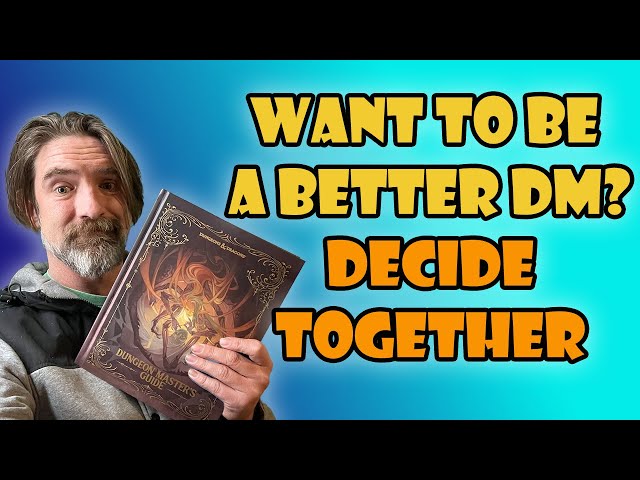William Tramp, the man behind the ‘This ‘Effin GM’ DnD YouTube channel, has shared the painful story of his brother’s death by suicide, to help explain the value of safety tools in tabletop roleplaying games. Via a thirteen minute video, Tramp explains both the circumstances of his brother’s death, and how safety tools helped him participate in a dark horror TTRPG while still grieving.
Tramp uploaded a thirteen minute video to his YouTube channel on Monday, following discourse on social media platform X about the validity of the safety tools found in the new Dungeons and Dragons DM guide.

Safety tools are intended to let players easily advocate for their personal boundaries, while minimising disruption to games. The DM’s guide includes suggestions like establishing a pre-agreed signal between players and DMs, such as crossing their arms in an ‘x’, to indicate that they want to end the current scene without discussion.
Critics consider the tools to give unwarranted power to a player, enabling them to impose their values on other players or the DM. Because loud or controversial voices that generate ‘discourse’ are prioritized by the X.com algorithm, it’s hard to know how many of these critics there actually are.
Others are simply non-plussed by them. Tramp himself acknowledges at the start of the video that he once did not see the purpose of safety tools for tabletop roleplaying games: until, sadly, he had a reason to use them.
Tramp recounts how, on February 18 2023, he discovered the body of his younger brother Shane. Shane had a history of attempting to take his own life, and had died by hanging on his birthday the day previously.
While Tramp was grieving the death of his brother, he still wanted to participate in TTRPGs. He had, historically, played with a group of friends he knew well, but he was now playing as part of a large group that contained some strangers. He knew that he was emotionally vulnerable, but “I was not quite ready to trauma dump on a whole group of people” – both for their sake and for his. “But I also really needed to be out of the house”, he says in the video.

Tramp was already part of a game of Zweihander, a medieval horror fantasy TTRPG where PCs have more in common with Warhammer Fantasy Roleplay‘s grimy murderers than the heroic DnD classes, that was being GMd by its author Daniel Fox. Death by strangulation was a feature of the game: people sentenced for high crimes would be executed by hanging, and the garotte was a high quality weapon available to the players.
Tramp anticipated that he would find descriptions of strangulation very upsetting. He and Fox discussed his situation. “If I was starting to feel uncomfortable, I would let him know”, Tramp says, and the pair “came up with a symbol that I would give”.
During the game “there would be moments, not often, when someone would choke somebody, and I would suck it up”, Tramp says in the video. But of course, players being players, and this being a medieval horror fantasy game, sometimes the descriptions would get graphic and detailed. So, “every so often the description would get onto someone dying in that fashion, I’d flash that signal, and the GM would move it along”.
To critics of safety tools who might argue that Tramp was diminishing the freedom of the other players and the DM, he says that there weren’t problems. “The other players started to realize and skip past that particular thing… and we still kept gaming”. The people in the group who were once strangers are now his friends.
He adds, “I am very thankful that my DM was willing to have that conversation with me… to hear me out and to decide… what sort of accommodations we can make”.
As our DnD expert Mollie Russell argued before the DMG had arrived on the DnD release schedule, the tools in the DnD DMG aren’t particularly revolutionary, instead being lifted or adapted from guidance developed by the wider TTRPG development community over more than a decade.
Tramp recommends them as a good starting point, particularly if you are running a public game, where players will naturally not want to disclose deep and personal aspects of their history to strangers. His advice, for people wishing to be a better DM, is not necessarily to use the tools from the DMG, but to be aware of the reasons why they might be needed, and to “take the time to find out how to handle legitimately traumatic situations with the people at your table”.
It is a fact of life that bad things happen to people. Sometimes, someone at your game table will also be adjusting to a traumatic event. Safety tools are not intended as an imposition on the DM and other players, but an accommodation that can be used, when needed, to help people stay at the table even when they’re hurting.
If you have experienced the death of a loved one to suicide, you can find helpful information at the American Foundation for Suicide Prevention. In the UK, the Survivors of Bereavement by Suicide charity provides peer to peer support.
Our Dungeon Master’s Guide review gives Wargamer’s full thought on the book. Our main DnD section has helpful guides for new and experienced players, such as exhaustive compendiums on the current DnD races and DnD backgrounds – two elements of the game that have been overhauled for the new 2024 rules.
Source: Wargamer




